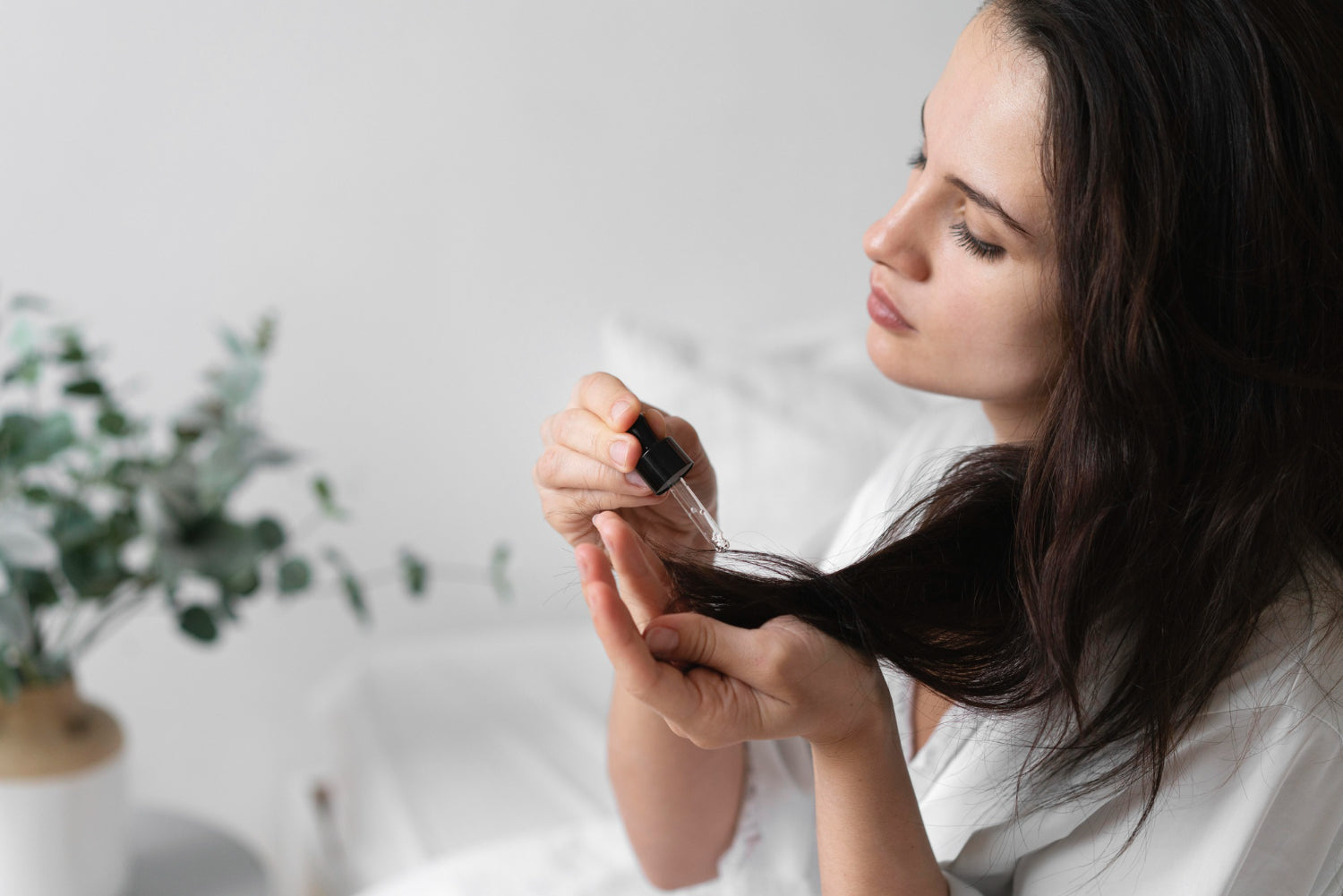Many factors can slow down hair growth, including nutrition, stress, genetics, and hormones. Learn how to foster regrowth with healthy styling practices, professional treatments, and simple lifestyle shifts.
You dream of long, healthy hair that effortlessly bounces and shines. Problem is, your hair grows so slowly. Sound familiar? If so, you’re among one-third of women who face similar challenges due to genetics, scalp health, stress, aging, and more.
If you’ve tried every trick in the book and still wonder, “Why does my hair grow so slow?,” we’re here to help.
As leaders in advanced Japanese hair technology, YA-MAN USA is proud to provide expert guidance and solutions to help you embrace your best hair. In this article, we explore the possible reasons behind strands that stand still and offer practical tips for faster hair growth.
Understanding the Hair Growth Cycle
Before answering the question, “Why is my hair not growing?,” it helps to understand the anatomy behind how it grows.
Hair growth follows a cyclical pattern called the hair growth cycle , which has four stages:
1. Anagen : the active growth period that lasts between two to six years.
2. Catagen : a brief transitional phase that lasts about two weeks, in which your hair stops growing.
3. Telogen : a resting phase, lasting around three months, during which your hair doesn’t actively grow.
4. Exogen : the shedding phase, in which old hair falls out and sets the stage for new growth.

A healthy scalp environment creates a solid foundation for hair follicles , making way for a seamless growth cycle and strong, healthy locks. A scalp primed for hair growth boasts:
Good blood flow : delivers nutrients and oxygen to your hair follicles, promoting robust growth during the anagen phase.
-
Balanced pH : prevents conditions like dandruff and fungal infections, which can clog hair follicles and impede growth.
-
Hydration : keeps your hair follicles healthy and prevents dryness that can lead to irritation and breakage.
-
Clean, clear follicles: no excess oil, product build-up, and dead skin cells, so hair follicles remain open and function properly.
-
Reduced inflammation : Inflammation can damage hair follicles and disrupt your growth cycle, leading to conditions like alopecia.
Healthy sebum production : Balanced sebum (natural oil) production moisturizes your hair without making it too oily, which can attract dirt and lead to clogged follicles.
Why is this important to know? It can help you pinpoint where issues arise, and whether you experience slow growth during the anagen phase or excessive shedding during telogen. Identifying these disruptions is key to learning how to grow hair fast.
Why Does My Hair Grow So Slow? 7 Common Causes
Now let’s discuss precisely what causes slow hair growth, because there are various factors to investigate.
Keep in mind that the cause will be unique for each person, but generally, these seven reasons are worth looking into.
1. Genetics
Your genetics play a significant role in hair growth. If your family has a history of slow growth, it’s not unusual for you to experience the same.
2. Medical conditions
Certain medical conditions, like Hypothyroidism, Anemia, and Autoimmune diseases, can disrupt your body's ability to supply essential nutrients and hormones to hair follicles. This weakens hair, slows growth, and makes it more prone to shedding.
3. Environmental factors
Exposure to pollution, UV rays, and harsh weather (like intense summer heat ) can damage the hair shaft and follicles, affecting how fast your hair grows.
4. Hormonal imbalances
Thyroid issues, polycystic ovary syndrome (PCOS), menopause, and pregnancy can alter hormones that regulate the hair growth cycle , leading to weaker and slower-growing hair.
5. Nutrition
What you put in your body can also dictate how your hair grows. If your diet lacks essential vitamins and minerals (like biotin, iron, and vitamin D), your hair could lag behind in growth.
6. Stress
Chronic stress triggers hair follicles to enter the telogen phase prematurely, slowing growth and increasing shedding. Physical stress on the scalp, like traumatic injuries or tight hairstyles, can even hinder growth in specific areas.
7. Aging
Signs of aging don’t just grace our skin; our hair’s growth rate naturally slows due to a shorter anagen phase and reduced follicle activity.
Once you isolate the cause, you can move on to the next step: learning how to fix stunted hair growth.

4 Strategies to Promote Scalp Health and Hair Growth
Many people want to know how to grow hair fast. The truth is, better-looking and healthier hair takes time and patience.
While you won't see inches grow overnight, consistent habits will lay the groundwork for a healthy, beautiful head of hair.
1. Try home remedies for slow hair growth
Have you ever looked around your house and thought: How can I speed up hair growth at home?
There’s a lot you can do with what you already have:
Massage your scalp to boost blood circulation to the hair follicles and promote healthy growth.
Try natural oils like Rosemary, Geranium, and Peppermint, all of which have been shown to improve scalp health and stimulate strong, lengthy strands.
Take hair growth supplements infused with Biotin, Aloe Vera, or Saw Palmetto to maintain scalp health, balance hormones, and promote healthy growth.
Incorporate styling tools that aid in hair wellness. For instance, our SPA STYLER® Blow Dry + Scalp Massage uses red light and infrared tech to enhance your hair and scalp health. The best part? It’s trichologist-recommended for a healthier scalp and enviable locks.

2. Invest in professional treatments
For those significant hair loss or genetic hair loss, learning what helps slow hair growth will require using treatments proven to stimulate hair regrowth.
Minoxidil : a topical treatment that stimulates your hair follicles and increases blood flow to the scalp, prolonging the anagen phase, and reviving dormant follicles.
Finasteride : an oral medication that inhibits testosterone conversion to dihydrotestosterone (DHT), a hormone that shrinks hair follicles. By reducing DHT, Finasteride delays hair loss and promotes regrowth.
Transplants : A surgeon relocates hair follicles from areas of the scalp with dense growth (usually the back or sides) to those that are thinning or balding. Afterward, the transplanted follicles grow naturally in their new locations.
Micropigmentation : A non-surgical procedure that deposits tiny amounts of pigment into patchy or balding areas of the scalp. This pigment mimics hair follicles and gives an illusion of a denser head of hair.
Platelet-Rich Plasma (PRP) : Injects concentrated platelets from your blood into the scalp. These platelets stimulate hair follicles, promoting healing and new growth.
3. Shift your lifestyle habits
Prioritizing self-care also cultivates healthier hair.
- Incorporate foods for hair growth into your diet:
|
|
|
|
|
|
|
|
|
|
Practice stress-relief techniques like scalp massages, meditation, yoga, and regular exercise to improve mental wellness and hair health.
4. Talk to your dermatologist
Sometimes, the smartest course of action is to consult your dermatologist. If you experience pain or irritation in the scalp, excessive hair loss, or drastically stunted growth, a quick visit to your doctor could provide the answers you need.

Reclaim Your Hair Growth Journey
We know it feels like you’ve been asking, “Why does my hair grow so slow?” for what seems ages. With the right knowledge and treatment, you can bring length and vitality back to your locks.
Fortify your hair growth journey with cutting-edge hair solutions from YA-MAN USA.



